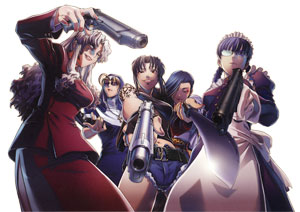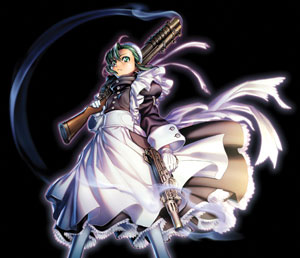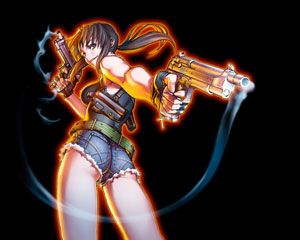 Logo handmade by Bannister
Column by Scott Green
Logo handmade by Bannister
Column by Scott Green
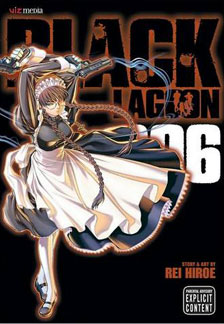
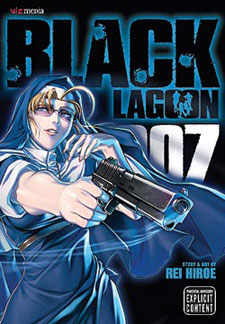
Black Lagoon Volumes 6 and 7 by Rei Hiroe Released by VIZ Media
It's been about 18 months since I last watched effusively praised mecha anime Gurren Lagann. While I did join that chorus, with the passage of time I've lost the ability to readily articulate why I was so enthusiastic about Gainax's work. I'm still under the impression that it was stylish and clever, but if someone were to say "eh, don't see why I should watch it," a pitch isn't about to roll off my tongue. Alternatively, it's been about 25 months since I've watch more than a couple of episodes of Madhouse's Sundae Katabuchi directed Black Lagoon anime, and I can still go on at length about the merits of that anime, which succeeds at its stated aims of out roasting the Hollywood action flick - both delighting in cooking notions of the pop pageant in their own excess and indicting all involved for reveling in violence. Set in the exotic locale of Roanapur, Thailand, a sort of criminal Galapagos, populated by miscreants, exiles, and expeditionary forces washed up on the shores of a pirate bay, Black Lagoon borrows from Terminator, Apocalypse Now, The Killer, torture porn, and just about any other spectacle of violence - a sort of Kill Bill style cocktail of stimuli. In 2010, the Black Lagoon anime will return with a new direct to video OVA. If you're as excited as I am about new Black Lagoon anime, you'll want to check out volumes 6 and later of the manga owing to the fact that this is the point at which the source material features content not previously adapted into anime. The first season of the anime ran April 8, 2006 - June 24 2006. Second Barrage ran October 2, 2006 - December 18, 2006. What's Black Lagoon been doing in the intervening years? Lagoon Company of the title is a PT boat service for hijacking and transporting people and material in the water around fictional Roanapur. The head of the quartet is the business' proprietor, African American, AWOL Marine/Vietnam veteran Dutch. On the lamb drop-out Benny handles the hardware. Then, there's the point of view and main attraction. Japanese businessman Rokuro Okajima - aka Rock - began his Roanapur venture as a Lagoon Company hostage. Then, through Stockholm Syndrome and/or rejection of his native, corporate value system, he ended up lending his limited services to Lagoon. Finally, Revy serves as the business' trouble shooter. She's a notably attractive young Chinese American woman, clad in Daisy Dukes and a black sleeveless that shows off her tribal tattoos. Armed with a pair of Berettas, "Two Gun" is both Black Lagoon's heavy and its chief male-baiting cover-girl. I'll admit that I've been reductive in my regard for Black Lagoon creator Rei Hiroe, appreciating and dismissing him in turn as a guy simply interested in drawing girls and guns. In favoring the anime, I credited Hiroe for conceiving a concept made more potent by Katabuchi's adaptation. While I'd still argue that Black Lagoon is fundamentally shaped by Hiroe's fascination with dressing up women in arresting outfits and accessorizing the ensembles by putting guns in their hands, my opinion of his work has been evolving as the manga has progressed. The last story adapted by the anime, "Fujiyama Gangsta Paradise" closed out volume five. This is a slight re-ordering of the manga's structure. Katabuchi's rationale for the decision is evident in that placing it there allowed the anime to sign off with events that were significant to its principal characters. Fujiyama Gangsta Paradise finds Rock and Revy in Japan. Rock had been hired out as translator for Russian paratrooper/Afghanistan veteran turned ethnic crime boss Balalaika in her Motel Moscow's vanguard operation. With Revy along to mind Rock's health, the business trip turns into a hard lesson in how being a would-be principled do-gooder or would-be lone gun-person is a direct route to getting Frogger splattered. And, that rule is especially true if the action crosses through the existential battles of large, determined entities... like Yakuza on their home turf clashing with Russian crime syndicates looking to expand. During his adaption of earlier stories, Katabuchi underscored Rock and Revy relationship or Rock's interpretation of Lagoon Company's action with darker notes of deep discomfort. Seeing Revy in action, anime Rock notes "I don't know what broke to make her like this, but I must be broken too if I'm standing here praising her destructiveness." Fujiyama Gangsta Paradise is different. Its anime and manga versions are remarkable similar, and in that, Hiroe demonstrates an interest and capacity for more than potently and precisely firearms and females. Beginning here, Hiroe begins working a thoughtful exploration of Black Lagoon's premise into his manga.The penultimate venture of the anime bats lead-off for the manga's sixth volume. This one doesn't really support the idea that Hiroe is backing the sizzle with substance. "Greenback Jane" is a palette cleanser that plays with Black Lagoon's notion of Roanapur as a multi-cultural stew pot of real and imagined criminal types. As Roanapur's residents simmer in the heat, Indian counterfeiter Janet Bhai manages to blow some fuses among her investors thanks to her stubborn perfectionism and inability to delivering time. On the run, she mistakenly seeks refuge in the "Rip-Off" Church of Violence where Eda, the blonde gunslinger/nun of the volume 7 cover, sets her up in a sleazy dive. Her former backers aren't too keen to see the product of their funding abscond, and as such, the local color as well as other assorted freelancers gather to track down Greenback Jane. So, returning heavies such as Taiwanese hatchetwoman Shenhua are joined by a freak show casting call that includes the likes of a goth girl/chainsaw maniac, a Mauser armed would-be suave dramatic geek and a chubby Caucasian American religious zealot/pyromaniac. The story features decidedly non-action-heroine Jane sliding down drain pipes, hollering, and generally setting the tone with her Run Through the Jungle routine. While the character isn't exactly an exaggerated dunce, she is ill prepared and ill dressed for Roanapur, where she draws attention a sort of catnip super-victim. Looking to cash in on the situation, Revy and Eda ostensibly offer her cover fire and engage the opposing hordes on Jane's behalf, but with ill tempered, trigger happy friends like that... And, Hiroe is similarly willing to take advantage of the techie in distress. She falls forward. He looks down her blouse. She slides down. He looks up her skirt. As afforded by the premise of Black Lagoon, "Greenback Jane" piles on a greedy helping of concepts for conflict resolution as offered by the global buffet of pop culture. Here, a bit of John Woo. There, a bit of Michael Mann. This quality gets to why Black Lagoon should be one of the great crossover hits of the latter 00's. I can pitch the joys of Oishibo till I'm blue in the face, but it's a infotainment foodie manga centering around an amusingly adversarial relationship between a stuck up, obstinate, overly formal father and his stuck up, obstinate, slacker son. As winning as it is, it is not going to draw from a huge pool of potentially interested. Alternatively, Hollywood has spent decades probing the depths of the audience pool for the bullets and bombs centerpiece of Black Lagoon. While the Hollywood comparison might imply planned cynicism, Black Lagoon is anything but. It's not girls and guns 'cause that's what sells. It's girls and guns 'cause that's what Rei Hiroe is really into. (Dated reference) like Kenichi Sonoda with Gunsmith Cats, Hiroe apparently relishes the idea of producing detailed rendering of fire arms held by woman conforming to his ideal female aesthetic. This is a guy who makes doujinshi fan comics of his own characters. As salacious and exploitative as Black Lagoon can be, it is also, apparently a passion project. The second half of volume six, into volume seven is where things get interesting, regardless of whether you’re a fan of the Black Lagoon anime or if you strictly follow the manga, as it's the start of El Baile de la Muerte. Some background for this story... The manga's second story, and the thrust of the anime's first season was Rasta Blasta. Recognizing that unconventional killers have become a familiar grind, Black Lagoon applies its tone and degree of violence to warrior maids and child assassins in such a way as to kick out the supports. Whether it is conveying fear or disgust, the manga always ensures that it is able to hit nerves rather than simply lean on ideas that have been overexposed beyond the point of outrageousness. Rasta Blasta served as the first wave of that attack. To Rock's dismay, cargo that Lagoon Company signed on to deliver turns out to be a child name Garcia Loveless, the heir to a once prominent, but now down on their luck South American dynasty. One of the family's few significant assets is the house hold maid, Roberta. Before rejecting her former life, Roberta was a FARC guerilla named Rosarita Cisneros, known as the "Bloodhound of Florencia" for her tenacious pursuit of her targets. With Garcia being held in Roanapur, she turns up, picks a fight that ends in the razing of Lagoon Company's favorite bar, and begins waging a one woman scorched earth campaign. When she concussed Revy than chases the car carrying Lagoon company, the characters aptly compare her to The Terminator. (3/4 of Lagoon Company are American and as such, Black Lagoon loves its American pop culture allusions. Perhaps too much. "I don't expect you to understand anyway! Not people who watch NY PD Blue and play with guns all day!" "Would you believe us if we told you we watch Oprah?" *groan*) El Baile de la Muerte opens in Venezuela with a Movimiento V República rally (Hugo Chavez's political party). A bomb goes off on stage and Diego Jose San Fernando Loveless is killed. Roberta drops off the radar, occasionally surfacing to make her presence know or to capture, torture and kill people believed responsible for her benefactor’s death. Then, a second maid turns up. This is the younger Fabiola Iglesias. She has a bit more joie de vivre than her robotic senior. However despite carrying around lollipops and looking for a pool in which to swim, this one has a bit more of a foul minded, tempestuous rage, which she exercises with capoeira kicks, twin automatic MAG-7s and a China Lake NATIC pump action grenade launcher. Then, premature head of the family, Garcia shows up and begins meeting with the on edge captains of Roanapur's criminal operations. There are several distinguishing factor to El Baile de la Muerte. First, its the Black Lagoon story that was not animated. Second, it tends towards the seriousness of Fujiyama Gangsta Paradise rather than the flighty frenzy of Greenback Jane. Third, and perhaps of primary importance, it's long. In Japan, it is still running 31 chapters in. For comparison, everything in the manga preceding it constitutes 43 chapters. That current length is twice as long as the manga version of Fujiyama Gangsta Paradise and ten times as long as Rasta Blasta. "I've heard mixed things about it" is usually a euphemistic phrase for "it has a bad reputation." In this case, I actually have heard mixed things about El Baile de la Muerte. On one hand, I've been told that the Black Lagoon that had not been adapted into anime had the same furious vigor as the material before it. On the other hand, I've been told that it's a good thing that the new Black Lagoon series will be an OVA of presumably fewer episodes than a TV series, because El Baile de la Muerte has felt interminable. While many popular manga are serialized weekly, Black Lagoon runs in Monthly Sunday Gene-X. As such, someone following the story chapter to chapter has been doing so for over three years, and I see how under those circumstances, Black Lagoon might lose some of its liveliness. In regards to the main attraction, El Baile de la Muerte has not turned out a colorful antagonist against which Revy can throw down against. In the scheme of Black Lagoon, there are crowds of toughs and then there are colorful individual super-predators - Revy, Eda, Roberta, Shenhua, Chow Yun Fat doppelganger Triad boss Mr. Chang. Acting alone, these super-predators can lethally cast aside nuisance toughs. Then, there are the trained, highly coordinated groups like the Russian ex-paratroopers, who can rain down a world of hurt on loan super-predators. So far, El Baile de la Muerte has been predators versus crowds of toughs. That's not to say the story has been dull. It's just been lacking highlights that measure against the best of what Black Lagoon has produced. Still, Fabiola back-kicking a guy in the gonads, doing a full split under a hail of gunfire then dance-fighting with an automatic weapon in each hand hits the vein of the action junkie. And, Black Lagoon maintains its solid baseline for illustrated violence. As a medium, the rapid run and gun sequences are not something that manga/comics are particularly well equipped to handle - look at the number of works that use shorthand to depict it or only show the set up and aftermath. In the interplay of angles and winds of speed lines, Hiroe is quite deft at depicting that brand of action. The click-boom of the grenade launcher, the upward angle catching the little girl with the big gun, the angled vectors as foes run at each other, guns down, Hiroe uses what he has to construct a blockbuster spectacle El Baile de la Muerte expands Fujiyama Gangsta Paradise's notion that Rock, Revy and company are teetering on a precarious edge. However, in this case, it's not just them. The fabric of Roanapur is composed of people who don't fit in - operatives locked into their mission or gone native, sociopaths (Revy), soldiers who fought on lost cause wars and can no longer go home (Dutch, Balalaika) and people who broke the wrong rules and were consequently shoved toward succeed from their upbringing (Rock, Benny). In this scheme, America is the bête noire, promising enforced conformity. In El Baile de la Muerte, Lagoon and the Roanapur gang bosses display rare concern that Roberta is in the process of bringing down the heat of a US agency alphabet soup, as well as military unconventional warfare forces onto their criminal haunt. Beyond that, there is an explicitly articulated worry that the real sleeping giant is the American public. Spark the wrong conflict, draw the sensational attention of CNN and you can kiss your anarchic den of vice goodbye. El Baile de la Muerte has yet to establish the Americans as a mortal threat. After pulling off the assassination of the elder Loveless, they've been knocked around by Roberta. Apart from one individual already known to readers, they haven't been the colorful sharks that represent singular threats to Revy and the like. Nor have they fielded a Hotel Moscow style wolf pack to take down any targets. As action antagonists, there has yet to be much there. As a force that both underscores and threatens the uniqueness of Roanapur, their presence forecast a collision of opposites. Introducing a bit of politics and a bit of non-conformist rebellion works as conceptually intriguing conflict baiting. Black Lagoon often sprints from one damn the torpedoes rush to the next, and that's a marquee characteristic of what is, first and foremost, a blistering action series. Still, a quality that I admire about the anime since its inception and the manga since Fujiyama Gangsta Paradise is its moments of sobriety. Between the rages of bloodlust-inebriation, Black Lagoon manages some introspection. El Baile de la Muerte in particular spends its inter-gunfire lulls humanizing the opposing forces in its conflict of tattooed, strangely dressed hard cases against Team America. Laid bare, Roberta is seen popping Ritalin and frying in her vengeful obsession. By the same token, while Hiroe isn't about to cast a chaste glance at Revy, scenes of her with hair down, doing crunches, or even showering are handled with as much humanity as one could possibly hoped for from this artist. Hireo also works some particularly sober moments into volume 7, with Rock and Revy trying to piece together the former's proclivity towards altruistic reactions and the latter's recent tendency to back him in lethal situations. In this scene, Hiroe honestly seems to be joining the pair in wrestling with why they jump into harm's way. Like Tarantino, Rei Hiroe masterfully cuts together sizzle reels of pop-culture influences. And like Tarantino, he is capable of adding his own, distinctive style and interpretations of those influences. Launching into its longest story to date, and conceivably the core of the manga, Black Lagoon manages to maintain its claim for a place among the superlative manga spectacles of violence, while adding some depth its characters and the concerns that define them.

